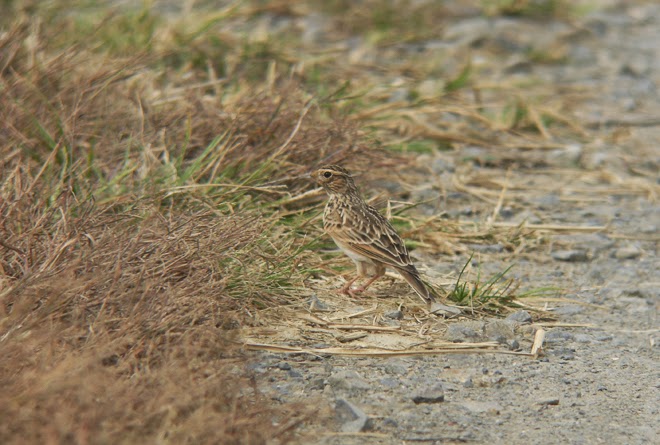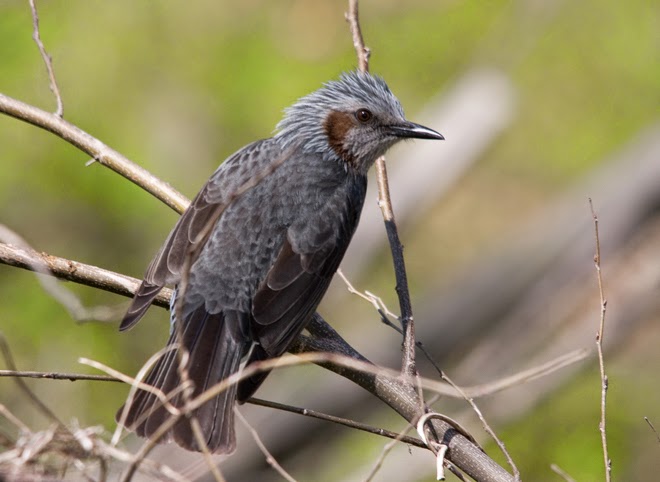Japanese (Eurasian) Skylark Alauda (arvensis) japonicus is a common breeder and winter visitor in Kansai and it's the only lark likely to be seen here. From late autumn onwards Skylark numbers build in open country, the weather playing a big part in how many may winter in the region. These birds aside, I've seen one Shore Lark in Mie and I heard of a party of a short-toed lark sp close to Ogura.
 Greater Short-toed Lark on Mishima, Yamaguchi, 3 May 2009. This species is reasonably regular, though not annual, on the island in spring.
Greater Short-toed Lark on Mishima, Yamaguchi, 3 May 2009. This species is reasonably regular, though not annual, on the island in spring.  Adult japonicus feeding juvenile along the Yodo River in Osaka, April 2007. I don't often get to see the short-lived juvenile plumage.
Adult japonicus feeding juvenile along the Yodo River in Osaka, April 2007. I don't often get to see the short-lived juvenile plumage.
One of a party of fresh plumaged birds on Hegurajima, 12 October 2011. This bird stood out because of broader paler fringes producing a much frostier than usual appearance and in keeping with the overall paleness the breast was only very lightly buffish. Nevertheless it looked otherwise identical to the other birds.
The taxonomic status of japonicus is unclear and birds I see are quite variable in plumage terms. The only lark I've seen well which really stood out as something different was a bird on Hegurajima. Even at a glance it was eye-catching, larger and heavier, as it flew over with 4-5 other larks. Fortunately they came down onto the short grass in the harbour where it lost nothing of its larger, bulky appearance. I didn't have a camera in those days and a few digiscoped images below are all I could get of it. Later some Japanese birders came along and called it O hibari, so they recognised it as a continental taxon. The images below don't convey how outstanding it was in the field.
Apart from being a stronger looking bird it differed slightly in plumage but I'm wary of relying on plumage features alone. Though the breast sides were more heavily marked than usual, flank streaks were more prominent and the lesser coverts were greyer.
As well as overall size the bill was longer and more powerful and the primary extension was longer with different spacing.
 Long primary extension with p3 clearly beyond p4, and the visible length of p4 more than half that of p5. Compare with the japonicus below, in my experience they show a less conspicuous p3 tip and the exposed length of p4 is half or less that of p5, irrespective of age/wear.
Long primary extension with p3 clearly beyond p4, and the visible length of p4 more than half that of p5. Compare with the japonicus below, in my experience they show a less conspicuous p3 tip and the exposed length of p4 is half or less that of p5, irrespective of age/wear.  The different angles and stance nothwithstanding the japonicus (left) looks smaller and slighter of build.
The different angles and stance nothwithstanding the japonicus (left) looks smaller and slighter of build.Zitting Cisticola is fairly common year round in the Kyoto area. They are less conspicuous in winter but they will display on calm sunny days. They are frequent in riparian grassland and overgrown fallow fields, walking through will often flush one.
 By contrast to the previous fresh bird, this is a very worn, dark individual on Okinawa, 3 August 2011.
By contrast to the previous fresh bird, this is a very worn, dark individual on Okinawa, 3 August 2011.Brown-eared Bulbul is extremely common in Kansai, from hill forests to city parks, it's impossible to miss. Even if sometimes you wish you could.
 A typical Brown-eared Bulbul in the botanical gardens Kyoto, 3 February 2013. Quite drab at first glance but they're actually quite attractive in an understated way.
A typical Brown-eared Bulbul in the botanical gardens Kyoto, 3 February 2013. Quite drab at first glance but they're actually quite attractive in an understated way.
















No comments:
Post a Comment